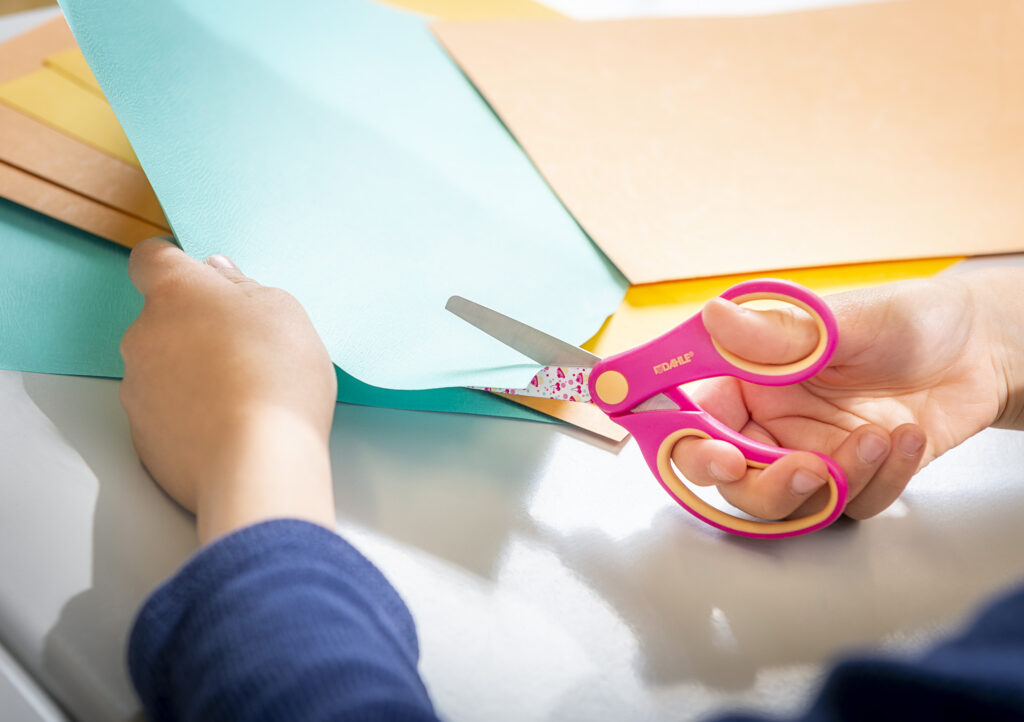Using scissors improves children’s fine motor skills
Children over the age of two are fascinated by scissors. After all, they watch their mum and/or dad using them every day and want to imitate the process. Often, however, they are more interested in how to use scissors by themselves, rather than in the result. They are eager to find out how the blades open, close and snip. But many parents still have ‘knives, forks, scissors and electricity are not suitable for small children’ stuck in their heads and ban their kids from using scissors for fear of them cutting themselves. Instead of banning and removing such a fascinating tool, however, it makes more sense to teach children how to use them competently and safely. Because after all, using scissors is about more than simply cutting up things like paper: it helps children develop their fine motor skills, strengthens the muscles in their hands and ideally prepares their wrists for writing. Using scissors also develops their imagination, dexterity and self-confidence – and ultimately represents another major milestone towards your child becoming independent.
By the time your child starts school, they should be able to use scissors safely. This is also part of the school entrance test. Read on to find out what is important when teaching your child how to use scissors, how to get started and which scissors are right for you. Their success will be rewarded with a ‘scissor permit’ – a source of pride and joy for your young scissor artists.
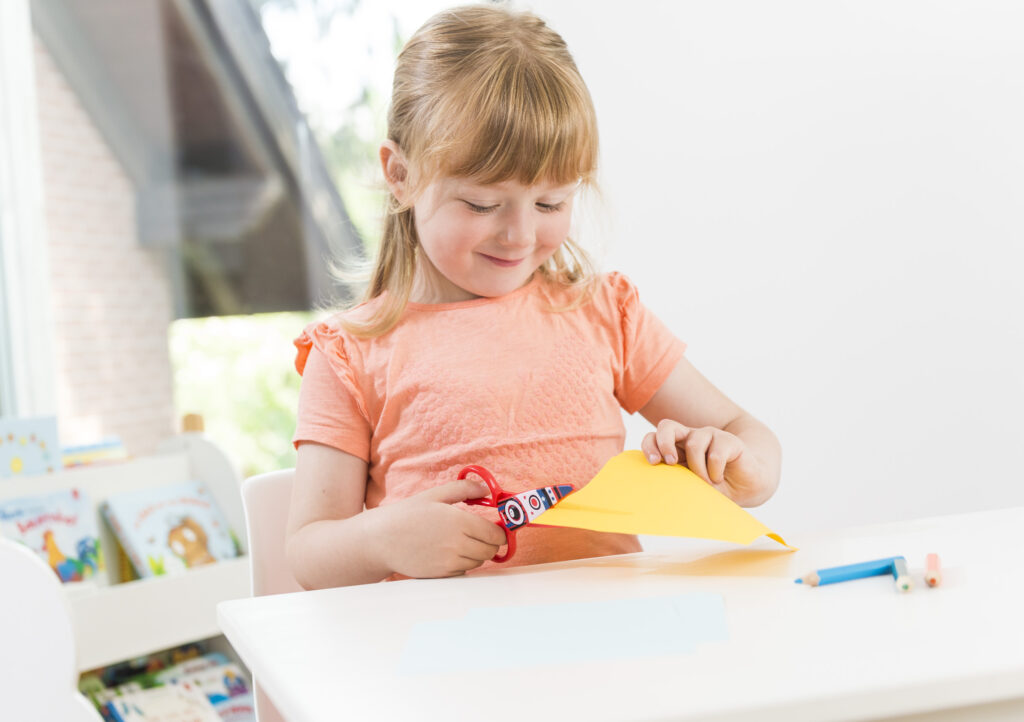
The basics
First of all, you should make it clear to your child that scissors are not a toy, but a tool that must be used with care. Without making them anxious, you should clearly point out that children can injure themselves with scissors – sometimes seriously.
Scissor rules
We also recommend that you establish some ‘scissor’ rules from the outset:
- No running, throwing, jumping or walking around with scissors in their hands – or anywhere else on their body.
- Scissors should only be used while sitting at a table and (initially) exclusively under adult supervision.
- Also practice safely passing scissors to and from your little one: scissors should only be handed over with their handles facing the other person, otherwise they could injure themselves on the blade. The blades must be closed and held in your hand.
- Children may only cut up objects that parents and/or teachers have explicitly given permission for. Do not allow your children to run through your home cutting up everything in their path. A note to parents at this point: play it safe and don’t leave important documents lying around.
Tip: instead of permanent bans, having a separate ‘cutting’ box might be a better solution: everything in this box can – and should even – be cut up. The contents could include coloured paper, wool, empty loo rolls, fabric, etc. You explicitly give permission for these to be cut up.
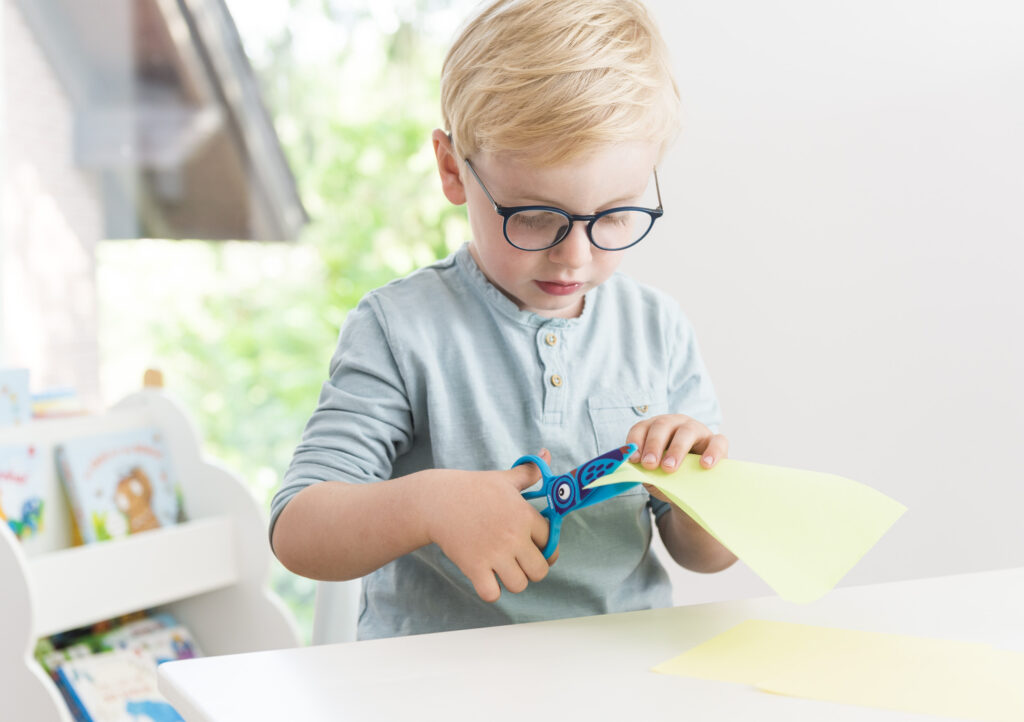
Which scissors are right for your child?
There are countless types of scissors. But the right scissors make creative activities and cutting out a lot more fun for both of you and ensure that your little one’s initial attempts at using scissors are a success. Paper scissors or children’s crafting scissors: Which children’s scissors are best for their initial attempts at using them? What do parents need to consider? Read on for some basic tips:
Size
Scissor size is particularly important: if they are too big and do not fit your child’s hands and fingers, they simply cannot be used properly. Your child will therefore be frustrated. So it’s just as well that children’s scissors are available in various sizes for different age groups.
Finger holes
There are models with finger holes of the same or differing sizes. Education experts are in two minds about this: in the case of scissors with equally sized finger holes, where your thumb goes in the upper hole and your middle finger in the bottom hole, your index finger sits in front of the bottom hole and controls the scissors. Scissors with a larger bottom hole have room for up to four fingers: you therefore use your whole hand to cut and not just two to three fingers. Ultimately, it comes down to what best suits your child and what they find easiest to use. So simply try both. We always recommend rubber padded, ergonomically shaped, soft handles for continued comfort while cutting.
Quality
Regardless of which scissors you choose, they should be high-quality to ensure that they give your child long-lasting enjoyment. After all, it doesn’t help anyone if your child’s initial experience of using scissors is unsuccessful, things go wrong, their cheap scissors break and, in the worst case, your child cuts themselves. So it is important to buy high-quality scissors! Non-rusting, special hardened steel blades are highly durable, and rounded blades are safe. Handles made of tough, unbreakable plastic, or ergonomically rounded soft handles guarantee that scissors will feel comfortable during use.
Colours and motifs
Bright colours and motifs on the blades, which will appeal to children, are a must, of course, but may encourage your little one to increasingly reach for their scissors in their favourite colour.
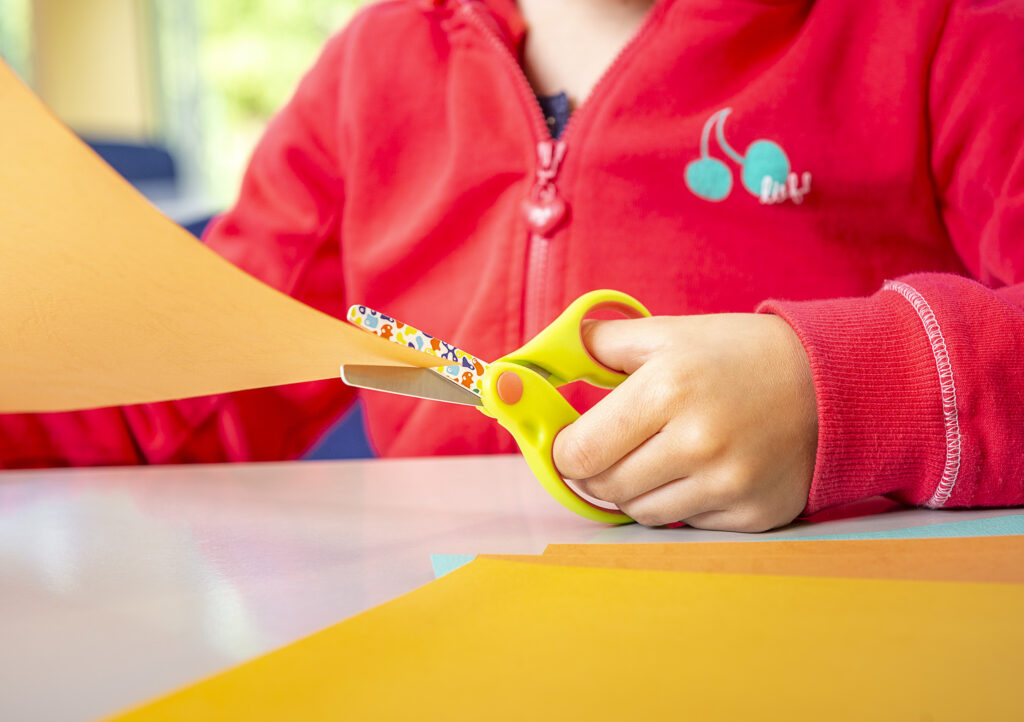
Right or left-handed scissors – is there really a difference?
Yes, there is! See for yourself: try using left-handed scissors with your right hand – or right-handed scissors with your left hand – to accurately cut a pre-drawn line. You’ll quickly realise that it is impossible to do this properly. Why is that? To achieve a precise cut, you must be able to see the cutting line. However, this is hidden when using scissors that are not suitable for your dominant hand. The cut will be crooked and/or imprecise. When using right-handed scissors, therefore, the left-hand blade goes under the paper so that the line is visible. While with left-handed scissors, the blades are the other way around, so the left-hand blade goes on top. This means that even children with a dominant left hand have a clear view of the cutting line.
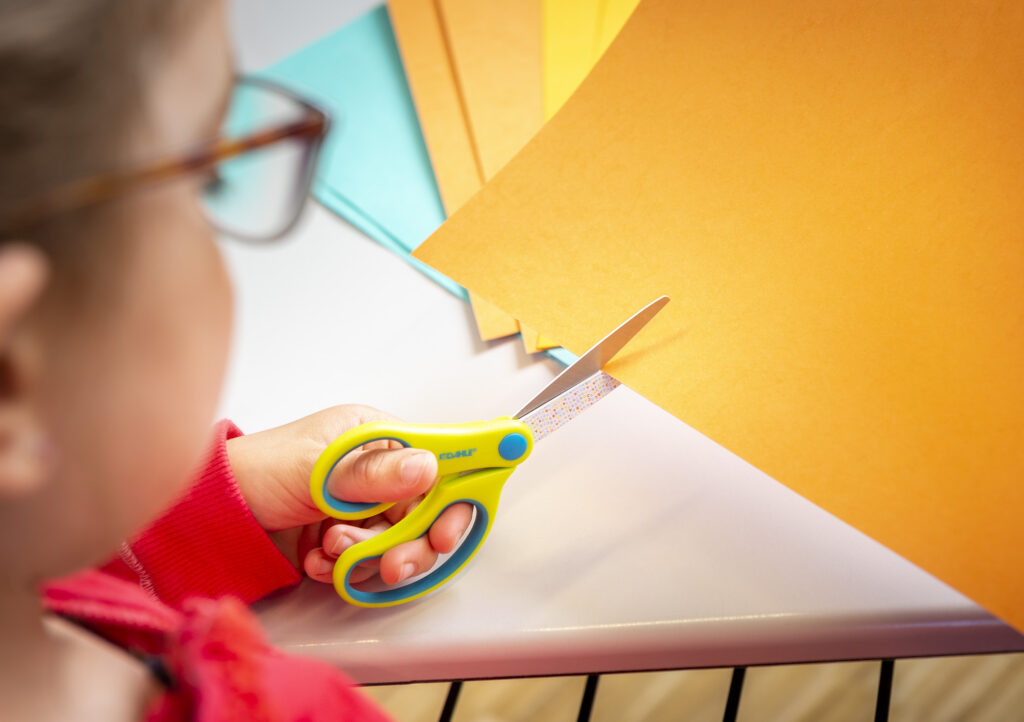
Scissors for different age groups
Which scissors at what age? We explain all.
Scissors for children under the age of two
The youngest beginners can start using scissors with plastic blades. These will only cut certain materials, such as thick paper, and are therefore extremely safe. It is almost impossible to cut skin or fabric with them, so your kids will be unable to damage their clothes or injure themselves.
Support scissors, such as therapy scissors that have no finger holes at all, learning scissors for children with weak hand muscles or practice scissors – with additional finger holes for adult hands – can also be used. These support scissors allow children to retain their motivation and interest in cutting.
Scissors for nursery-age children
Often, children over the age of three and nursery-age children can already use scissors independently. ‘I can do that by myself’ – is probably one of the most popular sentences among children in this age group. Often, they are already able to cut lines and shapes. Steel scissors with shorter rounded blade tips are suitable for use at home. They help children achieve initial success, make crafting fun, mean they can be proud of their results and also make great gifts.
Scissors for pre-school children
Scissors with slightly longer blades are ideal for children over the age of five. They are easy for children to hold and can be used to undertake more complex cutting tasks. Always make sure that the blades are sharp and that the finger holes are large enough and comfortable. For safety reasons, these scissors should also have rounded blade tips.
Scissors for primary school children
At this age, scissors with longer blades and rounded tips are also recommended. Extras such as a centimetre-ruler on the blades are a useful addition in primary school. It is no wonder that many primary school teachers recommend Dahle scissors for school bags. If children are sufficiently proficient, pointed paper scissors are also suitable during primary school and can be used to complete more challenging craft and cutting projects.
The Dahle scissors range contains a large selection of children’s and crafting scissors. You will definitely find the right scissors for your kids here. It is best to choose them together, so that your little one is involved in the process from the outset and is guaranteed to select their favourite colour or motif.
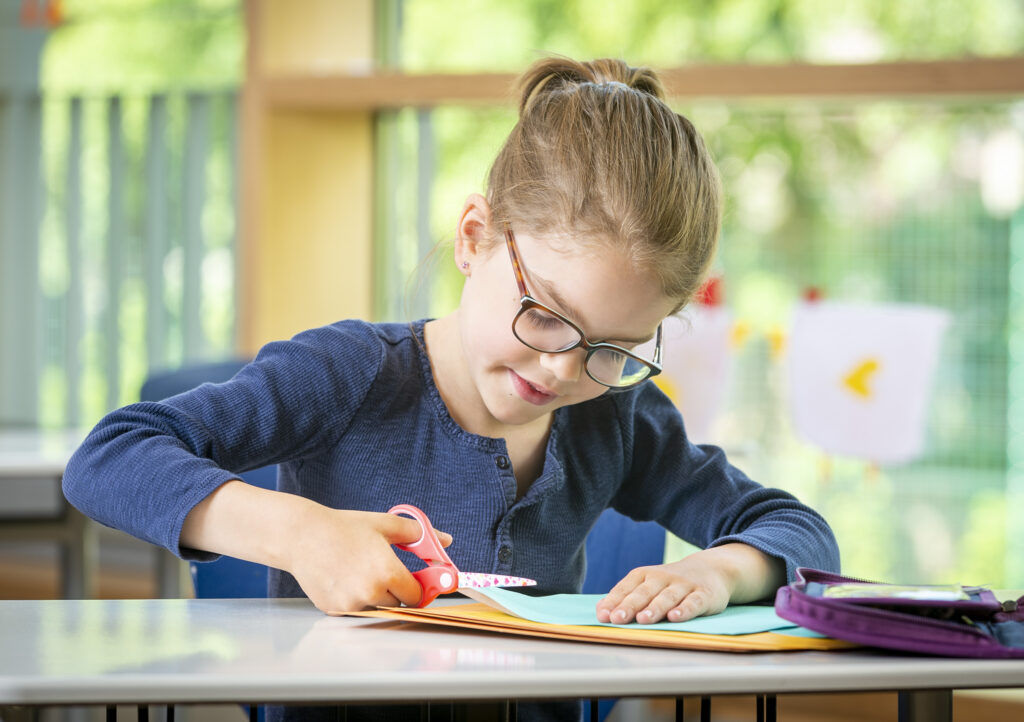
How does my child practice using scissors?
There are various exercises to help your child learn how to use scissors properly and cut out initial shapes and figures. Start with simple lines and gradually increase the level of difficulty, finishing with more complex figures.
Material
For their initial attempts, it is best to choose thick paper and/or thin card. This is thin enough to cut easily without a great deal of effort and strong enough to hold securely. This will retain your offspring’s motivation and ensure that their initial learning is a success.
Templates
You are welcome to use our scissor permit cutting templates for your child’s initial cutting exercises. These are sorted in ascending order of difficulty. Simply download, print on paper of your choice and cut out:
Achieving our ‘scissor permit’, cut by cut
Scissors and paper selected? Then use our ‘scissor permit’ to playfully teach kids how to use scissors. In addition to ‘scissor rules’, this also contains cutting exercises of varying levels of difficulty. Are all templates precisely cut out? Then your child now knows how to use scissors and you can award them their scissor certificate.
You can download our ‘scissor permit’ here:
